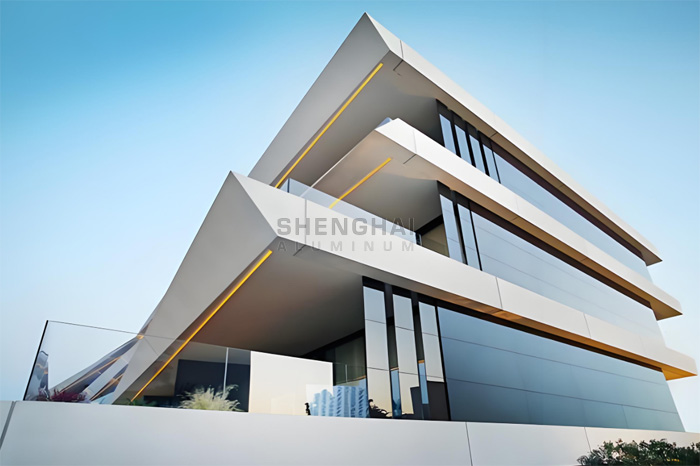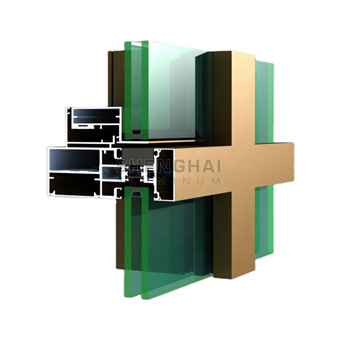What Is Aluminum Curtain Wall
Updated: 18 Nov 2025
Aluminum curtain walls are architectural envelope structures installed on the exterior of buildings, consisting of panels and supporting frames. They possess a certain load-bearing and deformation capacity, capable of accommodating the main structure's displacement, but do not bear the primary load of the main structure. Their function is only external, serving a protective or decorative purpose.

Curtain wall possesses a complete load-bearing structure, capable of withstanding wind loads, its own weight, etc., and transferring these forces to the main structure.
Flexible Connection to the Main Structure:
Curtain wall is typically "hung" onto the main structure using movable or flexible connectors. When the main building shifts (e.g., due to temperature changes, settlement), the curtain wall can adapt without significant damage.
Does Not Bear the Primary Load of the Main Structure:
Aluminum curtain wall only bears its own relevant loads and does not bear the primary mechanical forces acting on the main structure.
1. Aluminum Frame Curtain Walls
Aluminum frame curtain walls generally include: frame and curtain wall, hidden frame curtain wall, and glass aluminum frame curtain wall. The aluminum frame is the core component of the glass curtain wall's supporting structure. Commonly used aluminum alloys include 6061, 6063, and 6063A. 6061 and 6063 possess excellent weldability, electroplating performance, corrosion resistance, and density, making them widely used.
2. Aluminum Metal Sheets
Aluminum metal sheets are typically made from 3000 and 5000 series aluminum alloys, or other aluminum materials with stronger corrosion resistance and mechanical properties. These materials offer good stability and moderate strength, making them a commonly used type of sheet material for curtain walls.
3. Thermal Insulation Profiles (Thermal Break Profiles)
Thermal insulation profiles are composite profiles formed by adding thermal break material between two aluminum profiles, commonly known as "thermally broken profiles."
Simply put, it's adding a "thermal insulation strip" between two aluminum profiles to block heat conduction between the metals, thus achieving thermal insulation.
Depending on the manufacturing method, thermal insulation profiles are mainly divided into two categories: strip-type and cast-in-place type.
Both processes achieve good thermal insulation performance; the only difference lies in the manufacturing method.
4. Aluminum Alloy Panels
Aluminum alloy panels and strips are commonly used as curtain wall panel materials. Currently, commonly used aluminum alloy panel materials in building curtain wall projects include single-layer aluminum panels, honeycomb aluminum panels, and aluminum-plastic composite panels.
Commonly used aluminum alloy panel material grades for curtain walls include 5005, 3003, 3004, 1050, 1060, 1100, and 8A06. A fluorocarbon coating is recommended for the aluminum panels.
Single-layer aluminum panels: The thickness of single-layer aluminum panels used for curtain walls should not be less than 2.5mm. The coating on the decorative surface of the aluminum single-layer panel should be smooth, uniform, and have a basically consistent color. Flow marks, wrinkles, bubbles, and other defects that affect use are not allowed. A slight orange peel effect is permissible, and the degree of permissibility is determined by the supplier and the buyer.
Aluminum-plastic composite panels: three-layer composites with plastic as the core and aluminum on both sides. A decorative and protective coating or film (collectively referred to as the coating) is applied to the product's surface as the decorative surface. Aluminum composite panels should have a clean and neat appearance. The decorative surface must not have indentations, marks, dents, unevenness, missed coatings, exposed plastic on both sides, ripples, bubbles, scratches, or abrasions. Aluminum composite panels are classified into ordinary and flame-retardant types according to their fire performance.
Honeycomb aluminum panels: Honeycomb aluminum panels are composite panels made by bonding aluminum alloy sheets as the front and back panels with an aluminum honeycomb core under high temperature and pressure. The design of honeycomb aluminum panels can be larger than that of single-layer aluminum panels, with a maximum panel size of 1.5m × 4.5m. In addition to fluorocarbon spraying, surface treatment methods can include pre-roll coating and colorfast finishing, making them commonly used in building curtain walls.
Quality Requirements for Aluminum Alloy Profiles
The dimensional tolerances of aluminum alloy profiles used in curtain walls should reach high or ultra-high precision. The thickness of the surface treatment layer on the decorative surface should meet the requirements in the table below:
Local Film Thickness: The average value of several (no less than 3) film thickness measurements taken on a surface of no more than 1 cm² on the decorative surface of the profile.
Average Film Thickness: The average value of several (no less than 5) local film thickness measurements taken on the decorative surface of the profile.
Common surface treatment methods for aluminum alloy curtain wall profiles include anodizing, powder coating, fluorocarbon coating, and paint coating. In actual curtain wall projects, the most commonly used methods are fluorocarbon coating and electrostatic powder coating.
1. Anodizing
Anodizing involves placing aluminum or aluminum alloy products as the anode in an electrolyte solution and applying an electric current to form a dense aluminum oxide film on the surface.
Compared to the natural oxide film on aluminum, anodized aluminum surfaces exhibit significantly improved corrosion and wear resistance, as well as decorative properties.
It is commonly used to enhance the durability and aesthetics of profile surfaces.
2. Powder Coating (Electrostatic Powder Coating)
Powder coating typically uses electrostatic spray equipment to evenly coat aluminum profiles with powder, which is then melted and cured by heating to form a film.
Simple process, high yield;
Low energy consumption, environmentally friendly, no pollution;
Can be applied at room temperature without preheating;
Thick coating, high hardness, good wear resistance and acid resistance.
3. Fluorocarbon Coating
Fluorocarbon coating is a high-performance electrostatic spraying process widely used for indoor and outdoor profiles.
Uniform, bright, and stable color; strong resistance to fading and atmospheric corrosion; outstanding wear resistance, weather resistance, and UV resistance.
4. Paint Coating
Paint coating involves using a spray gun to apply paint to the surface of the profile, which is then allowed to dry naturally or at high temperature to form a coating film.
Suitable for applications requiring a certain surface finish.
The process is relatively traditional, with a longer construction period. The primer provides excellent rust protection and adheres well to the aluminum substrate and topcoat, significantly improving the coating's overall corrosion resistance and extending its lifespan. During application, only basic degreasing and rust removal of the aluminum surface is required; no additional phosphating is needed before direct primer application, simplifying the process. The coating is uniform, smooth, and has a fine, smooth surface, a major advantage of traditional liquid spraying.
However, its disadvantages are also significant: poor environmental performance, a long production cycle, cumbersome procedures, and a certain fire risk; furthermore, its wear and stain resistance are inferior to those of powder coating.
Aluminum curtain walls are an ideal choice for modern architecture. Their corrosion resistance, heat insulation, and design flexibility make them increasingly popular in large-scale buildings. Aluminum curtain walls come in various types and can be customized to meet different architectural styles and functional requirements.
Shenghai Aluminum has accumulated extensive experience in architectural aluminum profiles for doors and windows, curtain walls, ceilings, and other applications, and has completed numerous outstanding projects. Feel free to contact us anytime for professional solutions and answers.

Features of Aluminum Curtain Walls
Independent Structural System:Curtain wall possesses a complete load-bearing structure, capable of withstanding wind loads, its own weight, etc., and transferring these forces to the main structure.
Flexible Connection to the Main Structure:
Curtain wall is typically "hung" onto the main structure using movable or flexible connectors. When the main building shifts (e.g., due to temperature changes, settlement), the curtain wall can adapt without significant damage.
Does Not Bear the Primary Load of the Main Structure:
Aluminum curtain wall only bears its own relevant loads and does not bear the primary mechanical forces acting on the main structure.
Types of Aluminum Curtain Wall Materials
Common materials for building curtain walls include: aluminum alloy, stone, glass, artificial panels, and sealing materials. Among these, aluminum alloy is the most widely used material, appearing extensively in both the supporting frame of glass curtain walls and the metal panels.1. Aluminum Frame Curtain Walls
Aluminum frame curtain walls generally include: frame and curtain wall, hidden frame curtain wall, and glass aluminum frame curtain wall. The aluminum frame is the core component of the glass curtain wall's supporting structure. Commonly used aluminum alloys include 6061, 6063, and 6063A. 6061 and 6063 possess excellent weldability, electroplating performance, corrosion resistance, and density, making them widely used.
2. Aluminum Metal Sheets
Aluminum metal sheets are typically made from 3000 and 5000 series aluminum alloys, or other aluminum materials with stronger corrosion resistance and mechanical properties. These materials offer good stability and moderate strength, making them a commonly used type of sheet material for curtain walls.
3. Thermal Insulation Profiles (Thermal Break Profiles)
Thermal insulation profiles are composite profiles formed by adding thermal break material between two aluminum profiles, commonly known as "thermally broken profiles."
Simply put, it's adding a "thermal insulation strip" between two aluminum profiles to block heat conduction between the metals, thus achieving thermal insulation.
Depending on the manufacturing method, thermal insulation profiles are mainly divided into two categories: strip-type and cast-in-place type.
Both processes achieve good thermal insulation performance; the only difference lies in the manufacturing method.
4. Aluminum Alloy Panels
Aluminum alloy panels and strips are commonly used as curtain wall panel materials. Currently, commonly used aluminum alloy panel materials in building curtain wall projects include single-layer aluminum panels, honeycomb aluminum panels, and aluminum-plastic composite panels.
Commonly used aluminum alloy panel material grades for curtain walls include 5005, 3003, 3004, 1050, 1060, 1100, and 8A06. A fluorocarbon coating is recommended for the aluminum panels.
Single-layer aluminum panels: The thickness of single-layer aluminum panels used for curtain walls should not be less than 2.5mm. The coating on the decorative surface of the aluminum single-layer panel should be smooth, uniform, and have a basically consistent color. Flow marks, wrinkles, bubbles, and other defects that affect use are not allowed. A slight orange peel effect is permissible, and the degree of permissibility is determined by the supplier and the buyer.
Aluminum-plastic composite panels: three-layer composites with plastic as the core and aluminum on both sides. A decorative and protective coating or film (collectively referred to as the coating) is applied to the product's surface as the decorative surface. Aluminum composite panels should have a clean and neat appearance. The decorative surface must not have indentations, marks, dents, unevenness, missed coatings, exposed plastic on both sides, ripples, bubbles, scratches, or abrasions. Aluminum composite panels are classified into ordinary and flame-retardant types according to their fire performance.
Honeycomb aluminum panels: Honeycomb aluminum panels are composite panels made by bonding aluminum alloy sheets as the front and back panels with an aluminum honeycomb core under high temperature and pressure. The design of honeycomb aluminum panels can be larger than that of single-layer aluminum panels, with a maximum panel size of 1.5m × 4.5m. In addition to fluorocarbon spraying, surface treatment methods can include pre-roll coating and colorfast finishing, making them commonly used in building curtain walls.
Quality Requirements for Aluminum Alloy Profiles
The dimensional tolerances of aluminum alloy profiles used in curtain walls should reach high or ultra-high precision. The thickness of the surface treatment layer on the decorative surface should meet the requirements in the table below:
Local Film Thickness: The average value of several (no less than 3) film thickness measurements taken on a surface of no more than 1 cm² on the decorative surface of the profile.
Average Film Thickness: The average value of several (no less than 5) local film thickness measurements taken on the decorative surface of the profile.
Surface Treatment Methods for Aluminum Curtain Walls
Aluminum Alloy Surface Treatment MethodsCommon surface treatment methods for aluminum alloy curtain wall profiles include anodizing, powder coating, fluorocarbon coating, and paint coating. In actual curtain wall projects, the most commonly used methods are fluorocarbon coating and electrostatic powder coating.
1. Anodizing
Anodizing involves placing aluminum or aluminum alloy products as the anode in an electrolyte solution and applying an electric current to form a dense aluminum oxide film on the surface.
Compared to the natural oxide film on aluminum, anodized aluminum surfaces exhibit significantly improved corrosion and wear resistance, as well as decorative properties.
It is commonly used to enhance the durability and aesthetics of profile surfaces.
2. Powder Coating (Electrostatic Powder Coating)
Powder coating typically uses electrostatic spray equipment to evenly coat aluminum profiles with powder, which is then melted and cured by heating to form a film.
Simple process, high yield;
Low energy consumption, environmentally friendly, no pollution;
Can be applied at room temperature without preheating;
Thick coating, high hardness, good wear resistance and acid resistance.
3. Fluorocarbon Coating
Fluorocarbon coating is a high-performance electrostatic spraying process widely used for indoor and outdoor profiles.
Uniform, bright, and stable color; strong resistance to fading and atmospheric corrosion; outstanding wear resistance, weather resistance, and UV resistance.
4. Paint Coating
Paint coating involves using a spray gun to apply paint to the surface of the profile, which is then allowed to dry naturally or at high temperature to form a coating film.
Suitable for applications requiring a certain surface finish.
The process is relatively traditional, with a longer construction period. The primer provides excellent rust protection and adheres well to the aluminum substrate and topcoat, significantly improving the coating's overall corrosion resistance and extending its lifespan. During application, only basic degreasing and rust removal of the aluminum surface is required; no additional phosphating is needed before direct primer application, simplifying the process. The coating is uniform, smooth, and has a fine, smooth surface, a major advantage of traditional liquid spraying.
However, its disadvantages are also significant: poor environmental performance, a long production cycle, cumbersome procedures, and a certain fire risk; furthermore, its wear and stain resistance are inferior to those of powder coating.
Aluminum curtain walls are an ideal choice for modern architecture. Their corrosion resistance, heat insulation, and design flexibility make them increasingly popular in large-scale buildings. Aluminum curtain walls come in various types and can be customized to meet different architectural styles and functional requirements.
Shenghai Aluminum has accumulated extensive experience in architectural aluminum profiles for doors and windows, curtain walls, ceilings, and other applications, and has completed numerous outstanding projects. Feel free to contact us anytime for professional solutions and answers.


